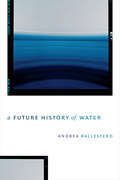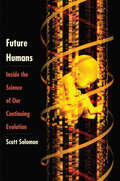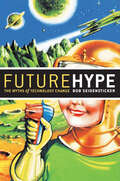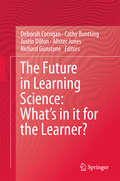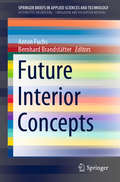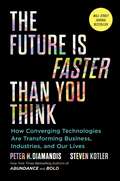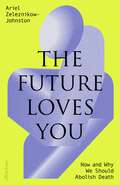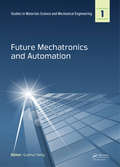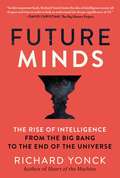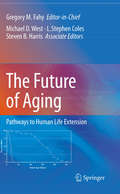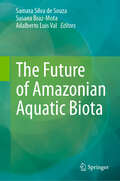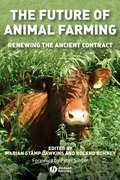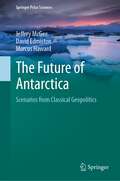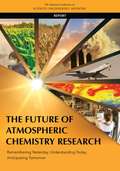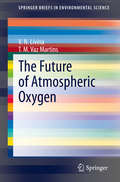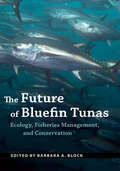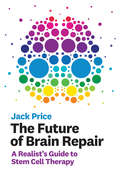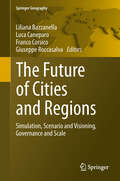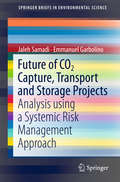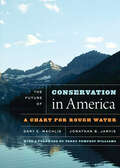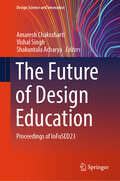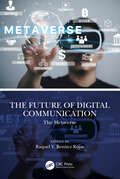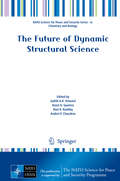- Table View
- List View
A Future History of Water
by Andrea BallesteroBased on fieldwork among state officials, NGOs, politicians, and activists in Costa Rica and Brazil, A Future History of Water traces the unspectacular work necessary to make water access a human right and a human right something different from a commodity. Andrea Ballestero shows how these ephemeral distinctions are made through four technolegal devices—formula, index, list and pact. She argues that what is at stake in these devices is not the making of a distinct future but what counts as the future in the first place. A Future History of Water is an ethnographically rich and conceptually charged journey into ant-filled water meters, fantastical water taxonomies, promises captured on slips of paper, and statistical maneuvers that dissolve the human of human rights. Ultimately, Ballestero demonstrates what happens when instead of trying to fix its meaning, we make water’s changing form the precondition of our analyses.
Future Humans: Inside the Science of Our Continuing Evolution
by Scott SolomonAn evolutionary biologist provides surprising insights into the changing nature of Homo sapiens in this &“important and an entertaining read" (Choice). In Future Humans, evolutionary biologist Scott Solomon draws on recent discoveries to examine the future evolution of our species. Combining knowledge of our past with current trends, Solomon offers convincing evidence that evolutionary forces are still affecting us today. But how will modernization—including longer lifespans, changing diets, global travel, and widespread use of medicine and contraceptives—affect our evolutionary future? Solomon presents an entertaining and accessible review of the latest research on human evolution in modern times, drawing on fields from genomics to medicine and the study of our microbiome. Drawing together topics ranging from the rise of online dating and Cesarean sections to the spread of diseases such as HIV and Ebola, Solomon suggests that we are entering a new phase in human evolutionary history—one that makes the future less predictable and more interesting than ever before.
Future Hype: The Myths of Technology Change
by Bob SeidenstickerEveryone knows that today's rate of technological change is unprecedented. With technological breakthroughs from the Internet to cell phones to digital music and pictures, everyone knows that the social impact of technology has never been as profound. Future Hype surveys the past few hundred years to show that many of the technologies we now take for granted transformed society in far more dramatic ways than recent developments so often touted as unparalleled and historic. Seidensticker exposes the hidden costs of technology and will help both consumers and businesses take a shrewder position when the next 'essential' innovation is trotted out.
The Future in Learning Science: What's in it for the Learner?
by Deborah Corrigan Cathy Buntting Justin Dillon Alister Jones Richard GunstoneThis volume considers the future of science learning - what is being learned and how it is being learned - in formal and informal contexts for science education. To do this, the book explores major contemporary shifts in the forms of science that could or should be learned in the next 20 years, what forms of learning of that science should occur, and how that learning happens, including from the perspective of learners. In particular, this volume addresses shifts in the forms of science that are researched and taught post-school - emerging sciences, new sciences that are new integrations, "futures science", and increases in the complexity and multidisciplinarity of science, including a multidisciplinarity that embraces ways of knowing beyond science. A central aspect of this in terms of the future of learning science is the urgent need to engage students, including their non-cognitive, affective dimensions, both for an educated citizenry and for a productive response to the ubiquitous concerns about future demand for science-based professionals. Another central issue is the actual impact of ICT on science learning and teaching, including shifts in how students use mobile technology to learn science.
Future Interior Concepts (SpringerBriefs in Applied Sciences and Technology)
by Anton Fuchs Bernhard BrandstätterIn this book, the authors highlight multiple aspects of and views on comprehensive automotive interior comfort for future mobility. In this context, passenger comfort comprises thermal, acoustic, seat perception, as well as human–machine interaction in the passenger cabin. In five chapters, the contributing authors, hailing from universities, research centers and industry, share their expertise and insights. They take a closer look at future interior concepts from the standpoints of fundamental and applied research, as well as practical aspects.
The Future Is Faster Than You Think: How Converging Technologies Are Transforming Business, Industries, and Our Lives (Exponential Technology Series)
by Steven Kotler Peter H. DiamandisFrom the New York Times bestselling authors of Abundance and Bold comes a practical playbook for technological convergence in our modern era.In their book Abundance, bestselling authors and futurists Peter Diamandis and Steven Kotler tackled grand global challenges, such as poverty, hunger, and energy. Then, in Bold, they chronicled the use of exponential technologies that allowed the emergence of powerful new entrepreneurs. Now the bestselling authors are back with The Future Is Faster Than You Think, a blueprint for how our world will change in response to the next ten years of rapid technological disruption. Technology is accelerating far more quickly than anyone could have imagined. During the next decade, we will experience more upheaval and create more wealth than we have in the past hundred years. In this gripping and insightful roadmap to our near future, Diamandis and Kotler investigate how wave after wave of exponentially accelerating technologies will impact both our daily lives and society as a whole. What happens as AI, robotics, virtual reality, digital biology, and sensors crash into 3D printing, blockchain, and global gigabit networks? How will these convergences transform today&’s legacy industries? What will happen to the way we raise our kids, govern our nations, and care for our planet? Diamandis, a space-entrepreneur-turned-innovation-pioneer, and Kotler, bestselling author and peak performance expert, probe the science of technological convergence and how it will reinvent every part of our lives—transportation, retail, advertising, education, health, entertainment, food, and finance—taking humanity into uncharted territories and reimagining the world as we know it. As indispensable as it is gripping, The Future Is Faster Than You Think provides a prescient look at our impending future.
The Future Loves You: How and Why We Should Abolish Death
by Dr Ariel Zeleznikow-JohnstonA brilliant young neuroscientist explains how to preserve our minds indefinitely, enabling future generations to choose to revive usJust as surgeons once believed pain was good for their patients, some argue today that death brings meaning to life. But given humans rarely live beyond a century – even while certain whales can thrive for over two hundred years – it’s hard not to see our biological limits as profoundly unfair. No wonder then that most people nearing death wish they still had more time.Yet, with ever-advancing science, will the ends of our lives always loom so close? For from ventilators to brain implants, modern medicine has been blurring what it means to die. In a lucid synthesis of current neuroscientific thinking, Zeleznikow-Johnston explains that death is no longer the loss of heartbeat or breath, but of personal identity – that the core of our identities is our minds, and that our minds are encoded in the structure of our brains. On this basis, he explores how recently invented brain preservation techniques now offer us all the chance of preserving our minds to enable our future revival.Whether they fought for justice or cured diseases, we are grateful to those of our ancestors who helped craft a kinder world – yet they cannot enjoy the fruits of the civilization they helped build. But if we work together to create a better future for our own descendants, we may even have the chance to live in it. Because, should we succeed, then just maybe, the future will love us enough to bring us back and share their world with us.
Future Magic
by Robert L. ForwardThis nonfiction book takes a crack at predicting the future and has some exciting prospects ahead for us.
Future Mechatronics and Automation: Proceedings of the 2014 International Conference on Future Mechatronics and Automation, (ICMA 2014), 7-8 July, 2014, Beijing, China (Studies in Materials Science and Mechanical Engineering)
by GuohuiYangThis proceedings volume contains selected papers presented at the 2014 International Conference on Future Mechatronics and Automation, held in Beijing, China. Contributions cover the latest developments and advances in the field of Mechatronics and Automation.
Future Minds: The Rise of Intelligence from the Big Bang to the End of the Universe
by Richard YonckFor Readers of Michio Kaku and Stephen Hawking, an Epic Journey through the Intelligent Universe With the ongoing advancement of AI and other technologies, our world is becoming increasingly intelligent. From chatbots to innovations in brain-computer interfaces to the possibility of superintelligences leading to the Singularity later this century, our reality is being transformed before our eyes. This is commonly seen as the natural result of progress, but what if there&’s more to it than that? What if intelligence is an inevitability, an underlying property of the universe? In Future Minds, Richard Yonck challenges our assumptions about intelligence—what it is, how it came to exist, its place in the development of life on Earth and possibly throughout the cosmos. Taking a Big History perspective—over the 14 billion years from the Big Bang to the present and beyond—he draws on recent developments in physics and complexity theory to explore the questions: Why do pockets of increased complexity develop, giving rise to life, intelligence, and civilization? How will it grow and change throughout this century, transforming both technology and humanity? As we expand outward from our planet, will we discover other forms of intelligence, or will we conclude we are destined to go it alone? Any way we look at it, the nature of intelligence in the universe is becoming a central concern for humanity. Ours. Theirs. And everything in between.
The Future of Advanced Nuclear Technologies: Interdisciplinary Research Team Summaries
by Committee on Clean Water Act Implementation Across the Mississippi River BasinThe National Academies Keck Futures Initiative (NAKFI) Conference in 2013 focused on the Future of Advanced Nuclear Technologies to generate new ideas about how to move nuclear technology forward while making the world safer and more secure. Beyond the public's apprehension concerning the safety of nuclear power, which calls out for better communications strategies, several challenges lie ahead for the nuclear enterprise in the United States. The workforce in nuclear technology is aging, there is an overreliance on large, high-risk reactor designs, and the supply of radioisotopes for nuclear medicine remains unstable--all problems crying out for solutions. The Future of Advanced Nuclear Technologies summarizes the 14 Interdisciplinary Research (IDR) teams' collaborations on creative solutions to challenges designed to propel the policy, engineering, and social aspects of the nuclear enterprise forward.
The Future of Aging
by Gregory M. Fahy L. Steven Coles Michael D West Stephen B. HarrisJust as the health costs of aging threaten to bankrupt developed countries, this book makes the scientific case that a biological "bailout" could be on the way, and that human aging can be different in the future than it is today. Here 40 authors argue how our improving understanding of the biology of aging and selected technologies should enable the successful use of many different and complementary methods for ameliorating aging, and why such interventions are appropriate based on our current historical, anthropological, philosophical, ethical, evolutionary, and biological context. Challenging concepts are presented together with in-depth reviews and paradigm-breaking proposals that collectively illustrate the potential for changing aging as never before. The proposals extend from today to a future many decades from now in which the control of aging may become effectively complete. Examples include sirtuin-modulating pills, new concepts for attacking cardiovascular disease and cancer, mitochondrial rejuvenation, stem cell therapies and regeneration, tissue reconstruction, telomere maintenance, prevention of immunosenescence, extracellular rejuvenation, artificial DNA repair, and full deployment of nanotechnology. The Future of Aging will make you think about aging differently and is a challenge to all of us to open our eyes to the future therapeutic potential of biogerontology.
The Future of Amazonian Aquatic Biota
by Samara Silva de Souza Susana Braz-Mota Adalberto Luis ValThe aquatic habitats of the Amazon region are subject to natural daily and seasonal variations in the physico-chemical properties of the water. The organisms that inhabit these habitats have developed adaptations to cope with these natural events. However, human-induced environmental changes are threatening ecosystems and affecting biodiversity at all levels of biological organization by causing drastic changes in climatic conditions in a shorter period of time, without giving organisms time to adapt. In this sense, the book addresses the future of aquatic organisms in the Amazon, including bacterial symbionts, insects, crustaceans, fish, plants, and amphibians, and provides an overview of what the future of biodiversity in the Amazon will look like, both in terms of organisms' adaptations to natural changes and in terms of vulnerability and responses to human impacts, highlighting possible mechanisms to minimize the expected impacts. The book also provides a brief overview of the risks that climate change poses to livestock, strategies for the sustainable use of species in the Amazon region and the impact of climate change on fish diseases.
The Future of Animal Farming: Renewing the Ancient Contract
by Marian Stamp Dawkins Roland BonneyDoes animal welfare have a place in sustainable farming, or do the demands of a rising human population and the threat of climate change mean that the interests of animals must be put aside? Can we improve the way we keep animals and still feed the world – or is it a choice between ethics and economics? The aim of this book is to challenge the "them-and-us" thinking that sets the interests of humans and farm animals against each other and to show that to be really "sustainable," farming needs to include, not ignore, animal welfare. The authors of this remarkable book come from a diversity of backgrounds: industry, animal welfare organizations, academic institutions, and practical farming. They are united in arguing that farm animals matter and that sustainable farming must have animal welfare at its ethical core, along with the production of healthy, affordable food and care for the environment.
The Future of Antarctica: Scenarios from Classical Geopolitics (Springer Polar Sciences)
by Jeffrey McGee David Edmiston Marcus HawardAs global great power competition intensifies, there is growing concern about the geopolitical future of Antarctica. This book delves into the question of how can we anticipate, prepare for, and potentially even shape that future? Now in its 60th year, the Antarctic Treaty System has been comparatively resilient and successful in governing the Antarctic region. This book assesses how our ability to make accurate predictions about the future of the Antarctic Treaty System reduces rapidly in the face of political and biophysical complexity, uncertainty, and the passage of time. This poses a critical risk for organisations making long-range decisions about their policy, strategy, and investments in the frozen south. Scenarios are useful planning tools for considering futures beyond the limits of standard prediction. This book explores how a multi-disciplinary focus of classical geopolitics might be applied systematically to create scenarios on Antarctic futures that are plausible, rigorous, and robust. This book illustrates a pragmatic, nine-step scenario development process, using the topical issue of military activities in Antarctica. Along the way, the authors make suggestions to augment current theory and practice of geopolitical scenario planning. In doing so, this book seeks to rediscover the importance of a classical (primarily state-centric) lens on Antarctic geopolitics, which in recent decades has been overshadowed by more critical perspectives. This book is written for anyone with an interest in the rigorous assessment of geopolitical futures - in Antarctica and beyond.
The Future of Atmospheric Chemistry Research: Remembering Yesterday, Understanding Today, Anticipating Tomorrow
by Engineering Medicine National Academies of SciencesOur world is changing at an accelerating rate. The global human population has grown from 6.1 billion to 7.1 billion in the last 15 years and is projected to reach 11.2 billion by the end of the century. The distribution of humans across the globe has also shifted, with more than 50 percent of the global population now living in urban areas, compared to 29 percent in 1950. Along with these trends, increasing energy demands, expanding industrial activities, and intensification of agricultural activities worldwide have in turn led to changes in emissions that have altered the composition of the atmosphere. These changes have led to major challenges for society, including deleterious impacts on climate, human and ecosystem health. Climate change is one of the greatest environmental challenges facing society today. Air pollution is a major threat to human health, as one out of eight deaths globally is caused by air pollution. And, future food production and global food security are vulnerable to both global change and air pollution. Atmospheric chemistry research is a key part of understanding and responding to these challenges. The Future of Atmospheric Chemistry Research: Remembering Yesterday, Understanding Today, Anticipating Tomorrow summarizes the rationale and need for supporting a comprehensive U.S. research program in atmospheric chemistry; comments on the broad trends in laboratory, field, satellite, and modeling studies of atmospheric chemistry; determines the priority areas of research for advancing the basic science of atmospheric chemistry; and identifies the highest priority needs for improvements in the research infrastructure to address those priority research topics. This report describes the scientific advances over the past decade in six core areas of atmospheric chemistry: emissions, chemical transformation, oxidants, atmospheric dynamics and circulation, aerosol particles and clouds, and biogeochemical cycles and deposition. This material was developed for the NSF’s Atmospheric Chemistry Program; however, the findings will be of interest to other agencies and programs that support atmospheric chemistry research.
The Future of Atmospheric Oxygen (SpringerBriefs in Environmental Science)
by V. N. Livina T. M. Vaz MartinsThis book investigates various aspects of the phenomenon of atmospheric oxygen depletion, and summarizes our current knowledge of atmospheric oxygen. The authors address the currently available records indicating that atmospheric oxygen is undergoing nonlinear decline. The consensus in the research community is that the main reason for this decline is the combustion of fossil fuels (which is growing nonlinearly). However, the short length of the currently available records, alongside the technological and social uncertainties that may risk speed up oxygen depletion, raise questions about the time scale of the decline, in particular, when oxygen depletion may cause physiological impact on humans and animals. The authors analyze this uncertainty to postulate the near term impact of depleted atmospheric oxygen, and perform multidisciplinary complex modelling of oxygen with long-term horizon estimations.
The Future of Bluefin Tunas: Ecology, Fisheries Management, and Conservation
by Barbara A. BlockThe most thorough and current account of scientific research on bluefin tunas—the largest, most sought-after tunas in the worldBluefin tunas are dominant keystone predators known for their impressive size, strength, endurance, and speed. Electronic tags have revealed that they can dive to great depths (over 6000 feet) and migrate vast distances—from frigid subpolar seas to warm tropical waters—for spawning. Prized for their rich taste and unique texture, bluefin tunas are also a worldwide commodity of great value. However, over the past few decades, overfishing throughout their range has led to significant population reductions.In The Future of Bluefin Tunas, Barbara A. Block brings together renowned bluefin experts from 15 different countries to share the latest information on the science, fisheries policy, and management decisions related to each of the three species within the Thunnus group—Atlantic, Pacific, and Southern. Synthesizing basic and applied research, the book delves into every aspect of these majestic fish, from their life history and genetic makeup to their ecology and migrations. Ichthyologists and marine scientists dedicated to the study of these fishes report on the latest stock assessments, explore the results of advances such as biologging and DNA sampling, and assess the potential of bluefin tuna aquaculture.The Future of Bluefin Tunas provides critical research findings to inform decisions that will impact tunas and the ocean ecosystems they affect. Scientists, fisheries managers, policymakers, and marine conservationists will take away key data from this timely volume to help them ensure these remarkable fish continue in perpetuity.
The Future of Brain Repair: A Realist's Guide to Stem Cell Therapy (The\mit Press Ser.)
by Jack PriceA scientist assesses the potential of stem cell therapies for treating such brain disorders as stroke, Alzheimer's disease, and Parkinson's disease.Stem cell therapies are the subject of enormous hype, endowed by the media with almost magical qualities and imagined by the public to bring about miracle cures. Stem cells have the potential to generate new cells of different types, and have been shown to do so in certain cases. Could stem cell transplants repair the damaged brain? In this book, neurobiologist Jack Price assesses the potential of stem cell therapies to treat such brain disorders as stroke, Alzheimer's disease, Parkinson's disease, and spinal cord injuries.Certainly brain disorders are in need of effective treatments. These disorders don't just kill, they disable, and conventional drug therapies have not had much success in treating them. Price explains that repairing the human brain is difficult, largely because of its structural, functional, and developmental complexity. He examines the self-repairing capacity of blood and gut cells—and the lack of such capacity in the brain; describes the limitations of early brain stem cell therapies for neurodegenerative disorders; and discusses current clinical trials that may lead to the first licensed stem cell therapies for stroke, Parkinson's and macular degeneration. And he describes the real promise of pluripotential stem cells, which can make all the cell types that constitute the body. New technologies, Price reports, challenge the very notion of cell transplantation, instead seeking to convince the brain itself to manufacture the new cells it needs. Could this be the true future of brain repair?
The Future of Cities and Regions
by Franco Corsico Giuseppe Roccasalva Liliana Bazzanella Luca CaneparoThis guide for tomorrow's urban practitioner systematically explains fifteen best practices across three continents; it explores questions of broad interest for designing and planning the future of cities and regions. Key questions addressed are: Is simulation useful to explore the effects of different design, policy and planning strategies? Which approach will help manage the uncertainties of metropolitan areas both today and tomorrow ? What are the strengths and weaknesses of the different simulation practices for city leadership, public and private partnership, and citizen involvement? The book reviews computer models and media, socio-political initiatives, professional practices which help communicating the future effects of different design, political and planning strategies with a wide range of aims: from information, through consultation, towards active participation. These world best practices are considered according to four leading issues for urban and regional development, respectively Simulation, Scenario and Visioning, Government and Governance, and Scale. The book examines the approaches adopted technically and procedurally. The selected knowledge and the innovative tools used in each case study are among the most advanced and up-to-date in the professional and research fields. This volume successfully illustrates these innovative practices and methodologies in a straightforward and accessible way.
Future of CO2 Capture, Transport and Storage Projects: Analysis Using A Systemic Risk Management Approach (SpringerBriefs in Environmental Science)
by Jaleh Samadi Emmanuel GarbolinoThis book presents a summary of a three-year research project on risk management for the Capture, Transport and Storage of CO2 (CTSC), offering an in-depth study on complex sociotechnical systems and systemic modeling. Approaching CTSC as a complex sociotechnical system, this book proposes systemic modeling as a decision-making aid. It offers a means of decision-making for the development of CTSC projects in the real-world context, where the future of the technology is uncertain. Risk management is considered as a means of control that can provide a control structure for the whole system.The risks associated with CTSC are not exclusively technical in nature; CTSC also faces a number of further uncertainties, from development to commercial scales.A major question concerning CTSC at the current scale of development is: "What are the factors explaining the success or failure of CTSC projects in different contexts?" In order to answer this question, the book proposes a systemic risk management framework based on the system dynamics and STAMP (Systems-Theoretic Accident Model and Processes) concepts.
The Future of Conservation in America: A Chart For Rough Water, With A Foreword By Terry Tempest Williams
by Terry Tempest Williams Gary E. Machlis Jonathan B. JarvisThis is a turbulent time for the conservation of America’s natural and cultural heritage. From the current assaults on environmental protection to the threats of climate change, biodiversity loss, and disparity of environmental justice, the challenges facing the conservation movement are both immediate and long term. In this time of uncertainty, we need a clear and compelling guide for the future of conservation in America, a declaration to inspire the next generation of conservation leaders. This is that guide—what the authors describe as “a chart for rough water.” Written by the first scientist appointed as science advisor to the director of the National Park Service and the eighteenth director of the National Park Service, this is a candid, passionate, and ultimately hopeful book. The authors describe a unified vision of conservation that binds nature protection, historical preservation, sustainability, public health, civil rights and social justice, and science into common cause—and offer real-world strategies for progress. To be read, pondered, debated, and often revisited, The Future of Conservation in America is destined to be a touchstone for the conservation movement in the decades ahead.
The Future of Design Education: Proceedings of InFuSED23 (Design Science and Innovation)
by Amaresh Chakrabarti Vishal Singh Shakuntala AcharyaThis book showcases cutting-edge research contributions from the International Symposium on Future of Design Education (InFuSED23) – written by eminent researchers from across the world on the topic ‘Future of Design Education’. The world is witnessing phenomenal change in terms of digital connectivity, movement from villages to towns and to megacities, major demographic movement across socio-economic strata, the looming threat of climate change and unsustainable development, terrorism and regionalism, major geopolitical shifts in the world order, and others. The practice of design, the “interdisciplinary discipline” as described by Nigel Cross, will have to play a major role in addressing the consequences of these changes, which by their very nature are people-centric and interdisciplinary. Therefore, design education must play a central role in training young minds in their evolving contributions as generic, empathic problem solvers for the world. InFuSED23 is intended to bring together top design researchers, teachers and thought leaders from across the world to deliberate on the topic “the future of design education” in its multiple perspectives: the aspects of design in which to train designers and design researchers, the manner in which the training is to be imparted, the levels at which training must be carried out, and so on.
The Future of Digital Communication: The Metaverse
by Raquel V. Benítez RojasThis collection of essays explores the present and future of digital communication through a range of interdisciplinary approaches, all of which focus on the so-called metaverse. The metaverse is a combination of multiple elements of technology – including virtual reality, augmented reality, and video – where users "live" within a digital universe. The vision for this new universe is that its users can work, play, and stay connected with friends through everything. Such a vision is hinted at in existing phenomena such as online game universes.
The Future of Dynamic Structural Science
by Judith A. K. Howard Hazel A. Sparkes Paul R. Raithby Andrei V. ChurakovThis work focuses on complementary crystallographic and spectroscopic areas of dynamic structural science, from papers presented at the 46th NATO sponsored course in Erice, Sicily 2013. These papers cover a range of material from background concepts to more advanced material and represent a fully inter-disciplinary collection of the latest ideas and results within the field. They will appeal to practising or novice crystallographers, both chemical and biological, who wish to learn more about modern spectroscopic methods and convergent advances and hence vice versa for experimental and computational spectroscopists. The chapters refer to the latest techniques, software and results and each chapter is fully referenced. The volume provides an excellent starting point for new comers in the emerging, multi-disciplinary area of time resolved science.
